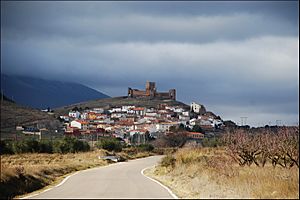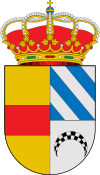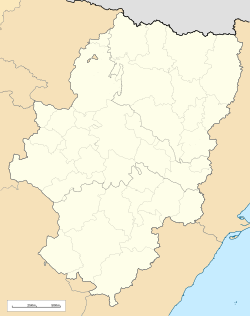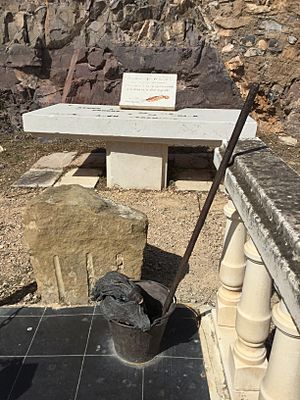Trasmoz facts for kids
Quick facts for kids
Trasmoz, Spain
|
||
|---|---|---|

Trasmoz overall view
|
||
|
||
| Country | ||
| Autonomous Community | ||
| Province | Zaragoza | |
| Comarca | Tarazona y el Moncayo | |
| Area | ||
| • Total | 18.26 km2 (7.05 sq mi) | |
| Elevation | 765 m (2,510 ft) | |
| Population
(2018)
|
||
| • Total | 89 | |
| • Density | 4.874/km2 (12.62/sq mi) | |
| Time zone | UTC+1 (CET) | |
| • Summer (DST) | UTC+2 (CEST) | |
Trasmoz is a small village in Spain, located in the province of Zaragoza in the region of Aragon. It has a population of about 96 people.
This unique town is famous for its many legends about witches and magic. Some of these stories were even written down by the famous author Gustavo Adolfo Bécquer. Trasmoz is the only town in Spain that was officially cursed and kicked out of the Catholic Church. This curse has never been removed!
Trasmoz truly embraces its connection to witchcraft. Every year, a special award called "Bruja del Año" (Witch of the Year) is given to a citizen. This award celebrates their contributions to the community and helps keep the town's history alive. White plaques are placed on the front doors of the winners' homes to remember them.
Contents
Trasmoz Through Time
Early History of the Village
The village of Trasmoz began a long time ago, in the 12th century. At first, it was a lordship, which means it was ruled by a lord. Over the years, it was sometimes part of the Kingdom of Navarre and sometimes part of the Kingdom of Aragon. Finally, in 1232, King Jaime I of Aragón took control of it for good. Later, in 1437, King Alfonso V gave the town to Don Lope Ximenez de Urrea.
A Famous Conflict and a Curse
After Don Lope passed away, his two sons argued over who would control Trasmoz. His youngest son, Pedro Manuel Ximenez de Urrea, eventually won. Pedro Manuel had a big disagreement, almost like a small war, with the nearby Veruela Abbey. They were fighting over water for irrigation. Because of this conflict, the Abbey decided to curse the entire town and remove all its people from the Church.
Around the year 1530, the Castle of Trasmoz was left empty. Later, a fire damaged its main tower. Many of the castle's stones and materials were then used to build other things in the area.
Exploring Trasmoz: Places to See
The Castle of Trasmoz
The Castle of Trasmoz was left empty in 1530. But in 1998, a man named Manuel Jalón Corominas bought the castle. He then created the "Foundation Castillo de Trasmoz" to help rebuild it.
The castle has a unique hexagonal shape, with towers at each corner. These parts were built between the 13th and 15th centuries. The oldest part is the main tower, called the "tower of homage." It has a square shape and is in the center of the castle. It used to have battlements on top, which are like walls with gaps for defense.
Today, the castle is home to the "Museum of Witchery." Here, you can learn all about the town's magical legends!
Church of Santa María de La Huerta
This church is built in the Gothic style, which was popular in the 16th century. The oldest part of the church is the arch of its main door. On this arch, you can see a special symbol called a Chi-Rho Christogram, which dates back to the late 13th century.
Nayim's Goal Street
This street is named after a very exciting moment in football history! It remembers an amazing goal scored by a player named Nayim. In 1995, during the final seconds of extra time in a big football match, Nayim scored a goal from about 45 yards away. This incredible shot broke a tie and helped his team, Real Zaragoza, win the 1995 UEFA Cup Winners' Cup.
Monument to the Mop
Manuel Jalón Corominas, the person who helped rebuild the castle, was also a famous Spanish inventor. He invented the modern mop and its bucket! He lived in Trasmoz for some time. After he passed away in 2011, a monument was built in his honor. The sculptor Luigi Maráez created this monument to celebrate his most famous invention, the mop.
Fun Facts About Trasmoz
- Long ago, some people were accused of making fake coins in the castle. These fake coins became known as "Maravedies falsos de Trasmoz."
See also
 In Spanish: Trasmoz para niños
In Spanish: Trasmoz para niños





